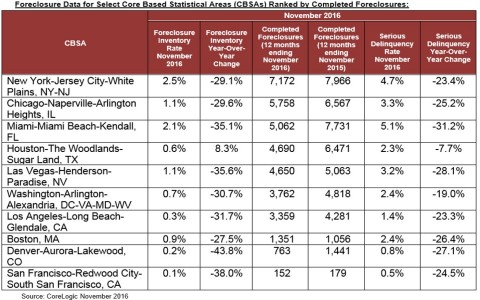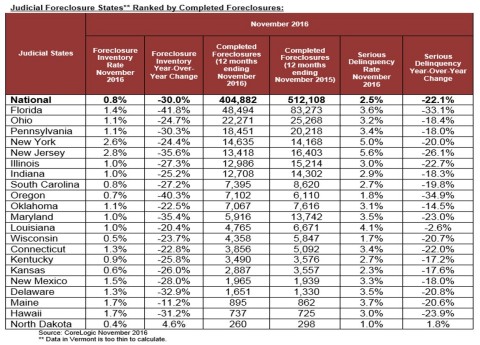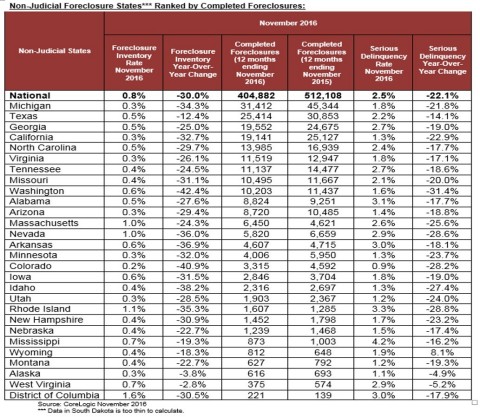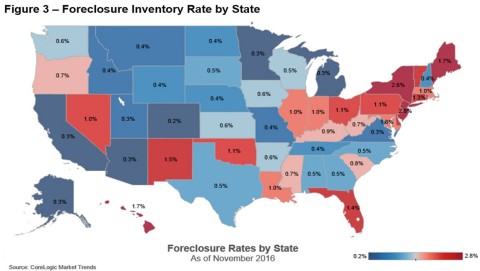IRVINE, Calif.--(BUSINESS WIRE)--CoreLogic® (NYSE: CLGX), a leading global property information, analytics and data-enabled solutions provider, today released its November 2016 National Foreclosure Report, which shows the foreclosure inventory declined by 30 percent and completed foreclosures declined by 25.9 percent compared with November 2015. The number of completed foreclosures nationwide decreased year over year from 35,000 in November 2015 to 26,000 in November 2016, representing a decrease of 78.2 percent from the peak of 118,339 in September 2010.
The foreclosure inventory represents the number of homes at some stage of the foreclosure process and completed foreclosures reflect the total number of homes lost to foreclosure. Since the financial crisis began in September 2008, there have been approximately 6.5 million completed foreclosures nationally, and since homeownership rates peaked in the second quarter of 2004, there have been approximately 8.6 million homes lost to foreclosure.
As of November 2016, the national foreclosure inventory included approximately 325,000, or 0.8 percent, of all homes with a mortgage, compared with 465,000 homes, or 1.2 percent, in November 2015.
CoreLogic also reports that the number of mortgages in serious delinquency (defined as 90 days or more past due, including loans in foreclosure or REO) declined by 22.1 percent from November 2015 to November 2016, with 1 million mortgages, or 2.5 percent, in serious delinquency, the lowest level since August 2007. The decline was geographically broad with year-over-year decreases in serious delinquency in 48 states and the District of Columbia.
“The decline in serious delinquency has been substantial, but the default rate remains high in select markets,” said Dr. Frank Nothaft, chief economist for CoreLogic. “Serious delinquency rates were the highest in New Jersey and New York at 5.6 percent and 5 percent, respectively. In contrast, the lowest delinquency rate occurred in Colorado at 0.9 percent, where a strong job market and home-price growth have enabled more homeowners to stay current.”
“The 7 percent appreciation in home prices through November 2016 has added an average of $12,500 in home-equity wealth per homeowner across the U.S. during the last year,” said Anand Nallathambi, president and CEO of CoreLogic. “Sustained growth in home prices is clearly bolstering homeowners’ spending power and balance sheets and, as a result, spurring a continued drop in defaults.”
Additional November 2016 highlights:
- On a month-over-month basis, completed foreclosures declined by 14.1 percent to 26,000 in November 2016 from the 30,000 reported for October 2016.* As a basis of comparison, before the decline in the housing market in 2007, completed foreclosures averaged about 22,000 per month nationwide between 2000 and 2006.
- On a month-over-month basis, the November 2016 foreclosure inventory fell 2.4 percent compared with October 2016.
- The five states with the highest number of completed foreclosures in the 12 months ending in November 2016 were Florida (48,000), Michigan (31,000), Texas (25,000), Ohio (22,000) and Georgia (20,000).These five states account for 36 percent of completed foreclosures nationally.
- Four states and the District of Columbia had the lowest number of completed foreclosures in the 12 months ending in November 2016: the District of Columbia (221), North Dakota (260), West Virginia (375), Alaska (616) and Montana (627).
- Four states and the District of Columbia had the highest foreclosure inventory rate in November 2016: New Jersey (2.8 percent), New York (2.6 percent), Maine (1.7 percent), Hawaii (1.7 percent) and the District of Columbia (1.6 percent).
- The five states with the lowest foreclosure inventory rate in November 2016 were Colorado (0.2 percent), Minnesota (0.3 percent), Arizona (0.3 percent), Utah (0.3 percent) and California (0.3 percent).
*October 2016 data was revised. Revisions are standard, and to ensure accuracy CoreLogic incorporates newly released data to provide updated results.
For ongoing housing trends and data, visit the CoreLogic Insights Blog: www.corelogic.com/blog.
Methodology
The data in this report represents foreclosure activity reported through November 2016.
This report separates state data into judicial versus non-judicial foreclosure state categories. In judicial foreclosure states, lenders must provide evidence to the courts of delinquency in order to move a borrower into foreclosure. In non-judicial foreclosure states, lenders can issue notices of default directly to the borrower without court intervention. This is an important distinction since judicial states, as a rule, have longer foreclosure timelines, thus affecting foreclosure statistics.
A completed foreclosure occurs when a property is auctioned and results in the purchase of the home at auction by either a third party, such as an investor, or by the lender. If the home is purchased by the lender, it is moved into the lender’s real estate-owned (REO) inventory. In “foreclosure by advertisement” states, a redemption period begins after the auction and runs for a statutory period, e.g., six months. During that period, the borrower may regain the foreclosed home by paying all amounts due as calculated under the statute. For purposes of this Foreclosure Report, because so few homes are actually redeemed following an auction, it is assumed that the foreclosure process ends in “foreclosure by advertisement” states at the completion of the auction.
The foreclosure inventory represents the number and share of mortgaged homes that have been placed into the process of foreclosure by the mortgage servicer. Mortgage servicers start the foreclosure process when the mortgage reaches a specific level of serious delinquency as dictated by the investor for the mortgage loan. Once a foreclosure is “started,” and absent the borrower paying all amounts necessary to halt the foreclosure, the home remains in foreclosure until the completed foreclosure results in the sale to a third party at auction or the home enters the lender’s REO inventory. The data in this report accounts for only first liens against a property and does not include secondary liens. The foreclosure inventory is measured only against homes that have an outstanding mortgage. Generally, homes with no mortgage liens are not subject to foreclosure and are, therefore, excluded from the analysis. Approximately one-third of homes nationally are owned outright and do not have a mortgage. CoreLogic has approximately 85 percent coverage of U.S. foreclosure data.
Source: CoreLogic
The data provided is for use only by the primary recipient or the primary recipient’s publication or broadcast. This data may not be re-sold, republished or licensed to any other source, including publications and sources owned by the primary recipient’s parent company without prior written permission from CoreLogic. Any CoreLogic data used for publication or broadcast, in whole or in part, must be sourced as coming from CoreLogic, a data and analytics company. For use with broadcast or web content, the citation must directly accompany first reference of the data. If the data is illustrated with maps, charts, graphs or other visual elements, the CoreLogic logo must be included on screen or website. For questions, analysis or interpretation of the data, contact Lori Guyton at lguyton@cvic.com or Bill Campbell at bill@campbelllewis.com. Data provided may not be modified without the prior written permission of CoreLogic. Do not use the data in any unlawful manner. This data is compiled from public records, contributory databases and proprietary analytics, and its accuracy is dependent upon these sources.
About CoreLogic
CoreLogic (NYSE: CLGX) is a leading global property information, analytics and data-enabled solutions provider. The company’s combined data from public, contributory and proprietary sources includes over 4.5 billion records spanning more than 50 years, providing detailed coverage of property, mortgages and other encumbrances, consumer credit, tenancy, location, hazard risk and related performance information. The markets CoreLogic serves include real estate and mortgage finance, insurance, capital markets, and the public sector. CoreLogic delivers value to clients through unique data, analytics, workflow technology, advisory and managed services. Clients rely on CoreLogic to help identify and manage growth opportunities, improve performance and mitigate risk. Headquartered in Irvine, Calif., CoreLogic operates in North America, Western Europe and Asia Pacific. For more information, please visit www.corelogic.com.
CORELOGIC and the CoreLogic logo are trademarks of CoreLogic, Inc. and/or its subsidiaries.







